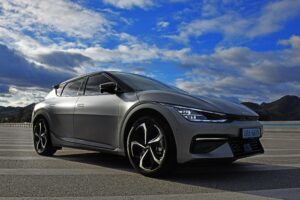
There are a few main ways in which electric vehicles (EVs) differ from your standard internal combustion engine (ICE) vehicles. The obvious distinction is the engine, but how the power that is generated from that engine is delivered to the wheels is also different.
It might be helpful to first understand how the transmission works in an ICE vehicle. There are four main types of transmissions: automatic, manual, automated manual and continuously variable transmission (CTV). Most ICE vehicles come with an automatic transmission. This is where the vehicle itself switches gears for the driver.
Here’s a simplified overview of the process:
The ICE generates power by igniting fuel (gas) and pushing the pistons down with a tiny explosion. On its downward thrust, the piston transfers power to the crankshaft. The harder you press on the pedal, the more quickly the process is completed, and the faster the vehicle goes. How fast the mechanical pieces turn is noted as rotations per minute (RPM), and the vehicle can only sustain up to a certain threshold of RPMs.
That momentum is then moved to either the torque-converter for automatic transmissions, or the clutch for manual. It keeps traveling from there to the transmission, engaging the correct gear from many options to accommodate the speed and power needed to propel the vehicle forward. There can be as many as 12 gears in a standard transmission. The transmission then sends the power to the drivetrain, which in turn moves the wheels.
Most EVs only have one gear. This is because with an electric engine, all the power is available instantaneously. No mechanical parts are turning inside the engine and therefore multiple gears are not needed to switch between lower and higher RPMs.
Since an electric motor can provide all its power, or torque, at once without mechanical pieces, one gear can manage all of the varying levels.
There is a place where the single gear is housed called the gearbox. ICE transmissions are also sometimes called gearboxes. So, technically there is a transmission on an EV, it just happens to be one gear instead of many. Some EVs have multiple gears, but those are exceptions to the rule. For example, the Jeep Magneto concept vehicle has a manual transmission with an electric motor.
While EVs don’t have a traditional transmission, there is a gearbox that is an integral part of transferring power from the engine to the drivetrain. Most EVs have only one gear, and that’s why this setup might not be considered by some to be a transmission. In the future, more EVs may have conventional transmissions, like in the case of the manual Jeep concept Magneto, or some other vehicles that are currently available.
Contact the any of our dealerships at Ontario Auto Center to learn more about available EVs and how they work.
While great effort is made to ensure the accuracy of the information on this site, errors can occur. Please verify all pricing information with a customer service representative. This is easily done by calling us or visiting us at the dealership.
Customer may not qualify for ALL Rebates shown. Some rebates are stackable and others can and cannot be combined. See Dealer For Complete Details.